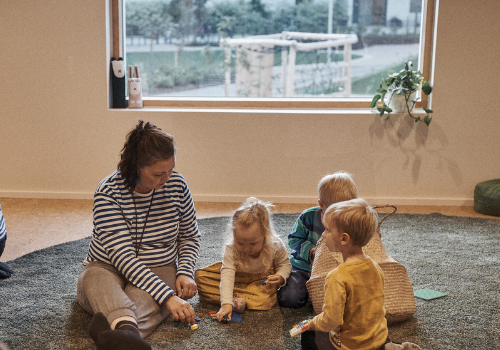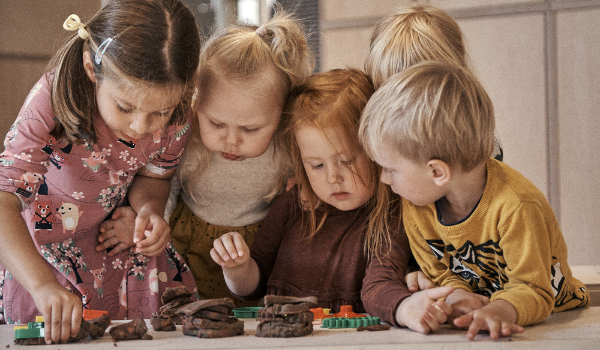Holistic Education versus Traditional Education During the Early Years

Holistic education and its approach is most often compared to traditional education methods when looking at how children learn and develop skills during their early years.
The biggest difference between the two is that traditional education focuses on results in separate, unrelated subjects while holistic education emphasizes the process of learning itself. With this method, different subjects are taught as one interrelated whole.
Key differences between holistic education and traditional education
There are several ways to present the differences between holistic education and traditional education during the early years. In this article, we will present some of the key areas in which these differences come to life.
- A dynamic classroom
- Learning self-confidence
- Real learning, not memorizing facts
Watch how Finland's holistic approach works:
A dynamic classroom
Let’s take a look at the traditional classroom and holistic classroom separately. They provide completely different learning environments, activities, and outcomes.
In a traditional classroom, children are passive learners of facts and numbers who repeat something that’s taught to them. The traditional classroom is reliant on conservative power setup, where the teacher is the rule-maker, and children constantly understand what's been expected of them. Children are able to speak only when they’re allowed to. Competition is encouraged and teaching is focused on getting results.
On the other hand, a classroom concentrated on holistic education is dynamic. The room is organized so that the focus is not on the teacher but on the subject. They bring the subject to life with experimenting, collaborating and child-focused activities. Learning is less linear. The process involves discovery and exploration, and this determines the length of the lesson. Children are directed towards self-learning, which emphasizes the joy of discovery.
An important part of holistic education is the practice of covering several learning areas at once through activities. There are no separate classes for subjects like math or physical education. Instead, when children learn mathematics, they simultaneously learn things like social-emotional skills and problem solving.
Even the design of a traditional classroom differs from a holistic one: a traditional classroom consists of rows of desks and chairs. Throughout the day, children sit there passively, listening to the teacher. In a classroom that’s focused on the holistic approach, the space is organized depending on what the children will be learning. They might, for example, sit in groups of three or four on pillows for small group activities. They could be working at a single table on a joint drawing project. The room is also very loud when the children co-operate, discuss and discover together. These early years activities truly engage them.
Learning Self-Confidence
Failure is a common concept in traditional education. When the goal of learning is to get a certain result or pass an exam, a child might feel overwhelmed. In holistic education, on the other hand, teachers aim to help children survive in the real world starting in their early years. This begins with building their self-confidence.
The holistic approach acknowledges that each child is unique and learns through different methods. Indeed, it emphasizes and takes advantage of these differences. Children learn to value themselves and trust their own special abilities. They also learn how to be persistent and resilient, which helps them tackle challenges. As a result, their self-confidence increases. This gives them a better base to grow and learn, not only during the early years, but also throughout their entire lives.
Real Learning, Not Memorizing Facts
Traditional classrooms concentrate on memorizing things by heart. Supporters of holistic education say that a better way to describe it is becoming “obsessed with facts”. In these traditional environments, teachers teach for a test, focusing on facts that the children then repeat back to them.
Holistic education during early years concentrates on learning skills that are needed in the real world like cooperation and teamwork. Children participate in creative activities that encourage critical thinking and learning more. They might, for example, participate in building something together. This creates a situation in which they need to work together in order to accomplish a goal, so teamwork is key.

How Does Holistic Education Exceed Traditional Education?
While it may be easy to default to focusing on a child’s intellectual abilities through traditional education during the early years, it is equally important for a child to develop skills such as:
- emotional intelligence
- confidence
- social ability
- compassion
- fine and gross motor coordination
- responsibility
- creativity
- self-agency
- and many other skills
Below are some important benefits that holistic education brings compared to the traditional approach:
- Improved academic achievement. One might naturally imagine that traditional education, which is in many ways concentrated on getting results, would also be better at ensuring further academic success. On the contrary, and according to many studies, holistic education improves the academic performance of all children already during the early years.
- Enhanced mental and emotional wellbeing. In a supportive environment where social and emotional learning is emphasized, children have a better chance of improved self-awareness, confidence and social skills. For example, just praising children instead of reprimanding them has a surprisingly positive effect on their behavior.
- Increased problem-solving abilities. Children who work on activities that are closely related to real-world problems also benefit from potentially finding solutions to those problems more easily than those in traditional education settings. They also learn how to collaborate with others in their early years.
- Reduced impact of inequality. The holistic approach to learning has been shown to reduce divisions between children. Instead of individual learning, children work in groups. This helps them become more understanding of others and curious about other cultures and ways of life.
On the Contrary, How Does Traditional Education Exceed Holistic Education?
Even though holistic education has many benefits, it might not suit everybody. It’s hard to start using this approach in a traditional environment where parents or school staff might be unsatisfied with its unordinary ideas and methods. For a child, it might also take some time to adjust to a more flexible classroom environment during their early years.
Instead, schools can take some elements from a holistic approach and concurrently follow the principles of traditional standards. Even a taste of holistic education might help children develop self-confidence and curiosity to continue learning.
Comparing The Performance of Children Who Received Holistic Education Values and Those Who Did Not
There have been numerous studies conducted by different educational institutions that compare children who have received holistic education to those who have not.
The research shows that holistic education has many advantages compared to traditional education, including:
- progress on child learning and development
- enhanced cognitive development
- enough opportunities for language development
- many opportunities to develop in various domains like, creative, socio-emotional, spiritual, aesthetic, fine
- motor and gross motor skills
- progress in the overall growth of the child
It has also been found out that people with average IQ (Intellectual Intelligence) but high EI (Emotional Intelligence) are significantly more successful than those with much higher IQs but lower EI. This is why early childhood educators are being challenged to integrate a teaching practice that focuses less on the traditional milestones of academic development, and more on the complete physical, emotional and psychological wellbeing of a child.
In a nutshell
In this digital era when the competition for kindergartens is high, it’s time to reconstruct the traditional curriculum. The holistic approach offers a solid solution to this. It focuses on overall learning instead of concentrating on their results and assessments.
We at HEI Schools strongly believe in holistic education during the early years with a focus on children’s development. We are a group of highly qualified pedagogical experts who know how to teach children through a holistic approach. We revolve around teaching that builds a child's personality and maintains innovativeness, flexibility and curiosity.
Our products, curriculum and activities are especially designed to encourage children to find their own special paths throughout the rest of their life. We focus on the holistic development of the children.
To find out more about how a holistic approach can help your children succeed in the long term, read more about how children learn at HEI Schools.



.jpg?width=352&name=how%20HEI%20Curriculum%20helps%20you%20to%20achieve%20Indias%20NEP%20(2020).jpg)

